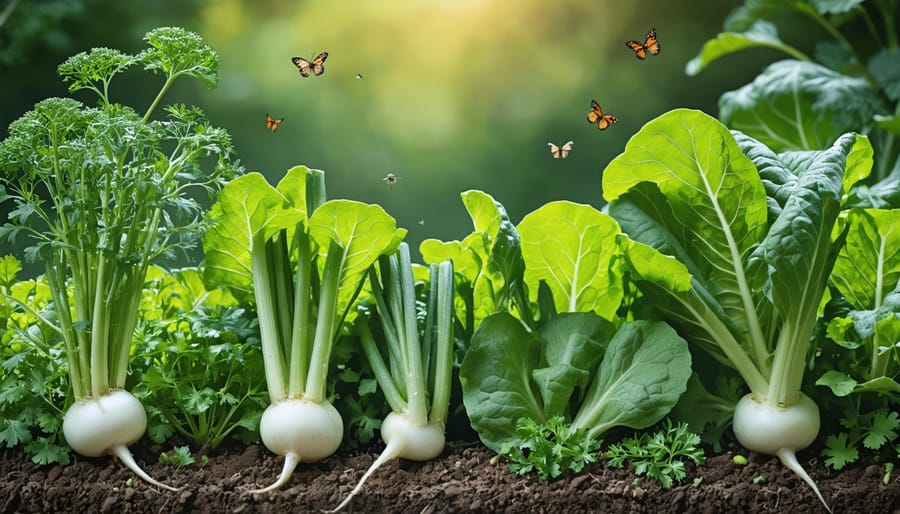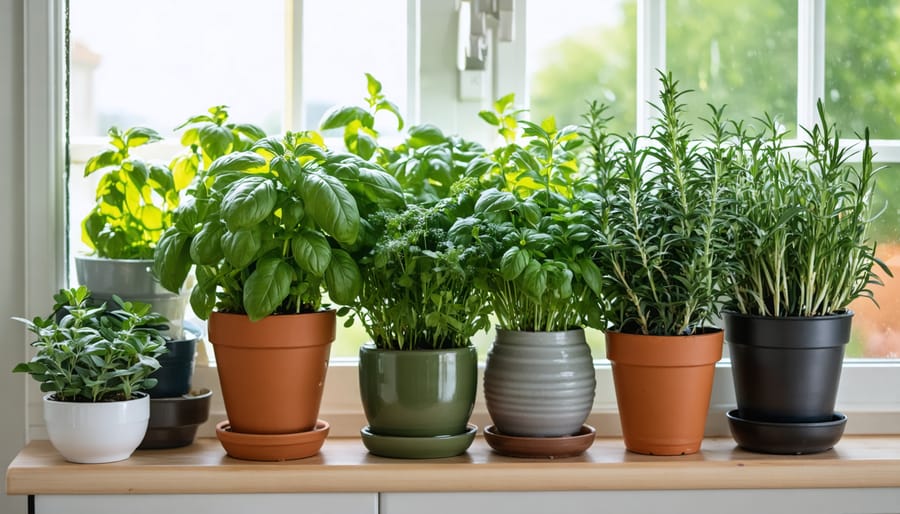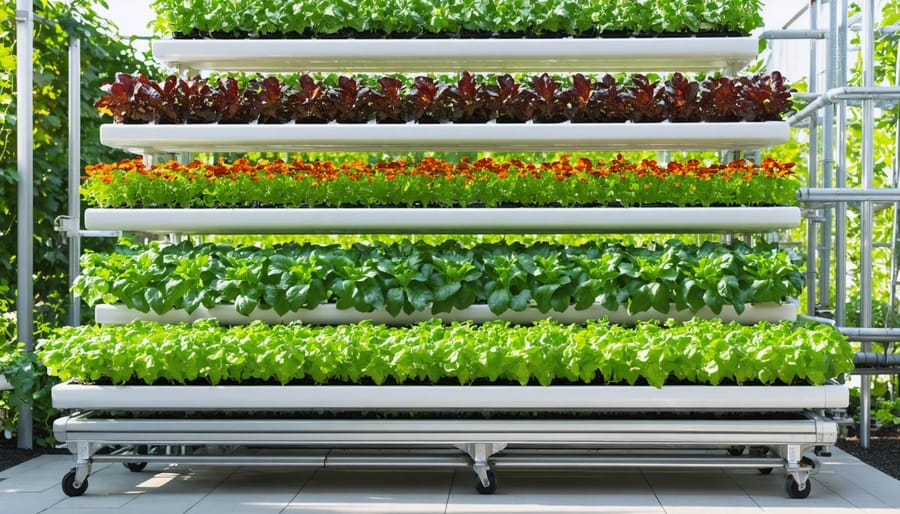Transform your limited outdoor space into a thriving garden oasis with an innovative PVC vertical garden system. These affordable, customizable structures offer a perfect solution for urban gardeners, combining space efficiency with impressive yields. By repurposing PVC pipes into sleek growing columns, you can cultivate everything from herbs to vegetables in a fraction of the traditional garden footprint. Whether you’re looking to maximize your balcony’s potential or create an eye-catching living wall, these vertical gardening ideas provide an accessible entry point into sustainable urban agriculture. With basic tools, a few lengths of PVC pipe, and some simple connections, you can construct a durable garden system that not only optimizes space but also ensures proper drainage and easy maintenance. This modern approach to gardening brings your plants to eye level, making tending and harvesting a breeze while creating a stunning visual impact in any outdoor setting.
Why PVC Makes Perfect Sense for Vertical Gardens
Material Benefits
PVC pipes offer numerous advantages that make them perfect for creating vertical gardens. First, they’re incredibly durable and weather-resistant, capable of withstanding various outdoor conditions without deteriorating. Unlike wooden structures that can rot or metal ones that might rust, PVC maintains its structural integrity for many years with minimal maintenance.
The lightweight nature of PVC makes it easy to work with during installation and allows for creative design flexibility. You can easily cut, drill, and modify PVC pipes using basic tools, making it an ideal material for DIY gardening projects. The smooth, non-porous surface prevents water damage and resists the growth of harmful bacteria or mold.
Cost-effectiveness is another significant benefit. PVC pipes are generally less expensive than alternative materials like cedar or steel, allowing you to create an impressive vertical garden without breaking the bank. They’re also readily available at most hardware stores, making replacement parts easy to find if needed.
Additionally, PVC’s natural white color reflects sunlight, helping to keep plant roots cooler during hot summer months. This feature is particularly beneficial for plants that prefer moderate soil temperatures.
Cost Comparison
When comparing PVC to other vertical garden materials, you’ll find it offers exceptional value for money. A complete PVC vertical garden system typically costs between $50-100, significantly less than pre-made metal or wooden alternatives that can run $200-500 or more. The materials are readily available at local hardware stores, and the pipes themselves usually cost just $3-8 per section.
Beyond the initial cost savings, PVC offers excellent durability and weather resistance. Unlike wooden structures that may rot or require regular maintenance, PVC stands up to the elements without needing treatments or replacements. Metal systems, while sturdy, can be prone to rust and are generally heavier and more expensive.
For budget-conscious gardeners, PVC’s lightweight nature also reduces shipping and installation costs. While specialized growing systems might offer sleeker aesthetics, they often come with premium price tags of $300 or more. The beauty of PVC lies in its combination of affordability, durability, and versatility, making it an excellent choice for both beginners and experienced gardeners looking to maximize their growing space without breaking the bank.

Essential Materials and Tools
Before you begin your PVC vertical garden project, gather all the necessary materials and tools. Here’s everything you’ll need to create your garden:
Essential Materials:
– PVC pipes (4-inch diameter recommended) – quantity depends on your design
– PVC end caps
– PVC T-joints and elbow joints
– PVC pipe cutter or hacksaw
– PVC cement/glue
– Drill with various drill bit sizes
– Measuring tape or ruler
– Permanent marker
– Sandpaper (medium-grit)
– Mounting brackets or wall anchors
– Screws and screwdrivers
– Level tool
– Garden soil or potting mix
– Fertilizer
– Plants of your choice
– Landscape fabric (optional)
– Paint primer and exterior paint (optional, for UV protection)
Additional Tools That Make the Job Easier:
– Safety glasses
– Work gloves
– Face mask (for cutting PVC)
– Clean rags
– Bucket for mixing soil
– Watering can or irrigation supplies
– Small trowel for planting
– Wire brush (for cleaning PVC)
Pro tip: Purchase extra PVC pieces to account for potential mistakes or design changes. It’s better to have a few spare pieces than to interrupt your project for another supply run. Remember to choose UV-resistant PVC pipes if your garden will be exposed to direct sunlight, or plan to paint them for protection. All materials can be found at most home improvement stores, and the total cost typically ranges from $50-150, depending on the size of your project.
Building Your PVC Vertical Garden
Planning and Design
Before starting your PVC vertical garden project, careful planning ensures optimal use of space and materials. Begin by measuring your intended installation area, considering both width and height. Remember to account for plant growth and accessibility – you’ll want to reach all plants easily for maintenance.
For a standard wall-mounted design, aim for panels roughly 4 feet wide and 6 feet tall, though these dimensions can be adjusted to suit your space. Leave at least 6 inches between planting rows to prevent overcrowding and ensure proper light distribution. When designing self-watering vertical garden systems, factor in a slight downward tilt (about 5 degrees) to facilitate proper drainage.
Sketch your design on paper first, marking the locations of support brackets, irrigation lines, and plant pockets. A good rule of thumb is to space plant pockets 8-12 inches apart, depending on what you’ll be growing. Consider sun exposure throughout the day – south-facing walls typically offer ideal conditions for most plants, while east or west-facing locations work well for shade-loving varieties.

Assembly Steps
Let’s get started with building your PVC vertical garden! Begin by laying out all your cut PVC pipes and fittings on a flat surface. This helps ensure you have everything ready and makes the assembly process smoother.
First, attach your mounting brackets to the wall where you plan to install the garden. Space them evenly, typically 16-24 inches apart, and use a level to ensure they’re perfectly straight. These brackets will be your garden’s foundation, so take your time getting them right.
Next, connect your main vertical PVC pipes to the mounting brackets. These should be secured firmly, as they’ll bear the weight of your entire garden. If you’re using multiple columns, maintain equal spacing between them for a balanced look.
Now comes the fun part! Attach your T-joints to the vertical pipes at your planned intervals. These will hold your horizontal growing tubes. Remember to position the T-joints so all planting pipes face the same direction. A good rule of thumb is to space them about 12 inches apart vertically.
Insert your horizontal growing pipes into the T-joints, ensuring they’re level. If you’ve pre-drilled your planting holes, make sure they’re facing upward. Apply PVC cement to all connections for extra stability, but work quickly as it sets fast.
Finally, cap the ends of all open pipes. This prevents water from escaping and keeps your system clean. Double-check all connections and make sure everything is secure before adding your irrigation system.
Pro tip: Before adding plants, run water through the system to test for any leaks and ensure proper drainage. This is also a great time to make any necessary adjustments to your construction.
Remember to give the PVC cement ample time to cure before adding soil and plants. Usually, 24 hours is sufficient, but check the manufacturer’s recommendations for best results.
Mounting and Safety
When mounting your PVC vertical garden, safety should always be your top priority. Start by selecting a sturdy wall or fence that can support the weight of your garden when it’s fully loaded with soil, plants, and water. For brick or concrete walls, use heavy-duty masonry anchors spaced every 2-3 feet. If mounting on wood, secure the structure with lag bolts into wall studs.
Before installation, check your wall for plumb using a level, and mark your mounting points carefully. Always work with a partner when lifting and securing PVC sections. For added stability, install diagonal bracing every 4-6 feet, especially for taller gardens.
Ensure all PVC joints are properly cemented and allow them to cure completely before adding plants. Install a safety cable at the top of the structure as a backup support system. Keep children and pets away during construction, and wear protective gear like safety glasses and work gloves.
Remember to position your garden where it won’t interfere with walkways or create tripping hazards. Regular maintenance checks of mounting points and structural integrity will help ensure your vertical garden remains safe and secure for years to come.
Plant Selection and Maintenance
Best Plants for PVC Gardens
When selecting plants for your PVC vertical garden, focus on varieties that have compact root systems and thrive in contained spaces. Herbs are excellent candidates for these gardens, and growing herbs vertically can provide you with fresh flavors right at your fingertips. Basil, oregano, thyme, and mint are particularly well-suited for PVC systems.
Leafy greens are another fantastic choice, as they’re lightweight and produce abundant harvests. Try growing lettuce, spinach, and arugula in your vertical setup. These plants have shallow root systems and can thrive in the limited soil space that PVC pipes provide.
For adding color to your garden, consider compact flowering plants like petunias, marigolds, and trailing lobelia. These plants not only beautify your space but also attract beneficial pollinators to your garden.
Small vegetables can also flourish in PVC gardens. Cherry tomatoes, bush beans, and compact pepper varieties are excellent choices. Just ensure your PVC pipes are wide enough (at least 4 inches in diameter) to accommodate their root systems.
For year-round interest, incorporate some hardy succulents and small ornamental grasses. These low-maintenance plants can withstand varying weather conditions and add texture to your vertical garden. Remember to group plants with similar water and light requirements together for easier maintenance and better growing success.

Care and Upkeep
Maintaining your PVC vertical garden doesn’t have to be complicated. Regular inspection of your irrigation system is crucial – check for clogged holes and clean them gently with a thin wire or toothpick. Every few weeks, ensure all pipe connections are secure and watch for any leaks that might develop at the joints.
Keep an eye on your plants’ soil moisture levels, especially during hot weather. While the PVC system helps conserve water, you may need to adjust watering frequency based on season and plant types. Test soil moisture by inserting your finger about an inch deep – if it feels dry, it’s time to water.
Prevent algae growth by ensuring proper drainage and avoiding overwatering. If you notice any green buildup on your PVC pipes, a simple solution of vinegar and water can help clean it off. During growing seasons, fertilize your plants monthly with a balanced, water-soluble fertilizer.
Periodically check the support system holding your PVC garden. Tighten any loose brackets or supports, especially after strong winds or storms. In colder regions, consider adding insulation around the pipes during winter months to protect plant roots from freezing.
Prune your plants regularly to maintain healthy growth and prevent overcrowding. Remove any dead or yellowing leaves promptly to discourage pest problems and diseases. With these simple maintenance steps, your PVC vertical garden will thrive for years to come.
Common Challenges and Solutions
While PVC vertical gardens are relatively low-maintenance, you might encounter a few common challenges along the way. Water distribution can sometimes be uneven, with plants at the top receiving more water than those at the bottom. To solve this, consider installing a drip irrigation system or adding extra drainage holes strategically throughout the structure.
Algae growth might occur in clear PVC pipes exposed to sunlight. Combat this by using opaque or painted PVC pipes, which block light and prevent algae formation. Some gardeners notice their plants becoming root-bound in the confined spaces. Address this by selecting appropriate plant varieties and regularly pruning both above and below the soil line.
Weight distribution can become an issue as plants grow larger. Ensure your structure is properly anchored and supported, using additional mounting brackets if needed. During hot summers, PVC pipes might heat up, potentially stressing plant roots. Combat this by painting the pipes with light colors or adding insulation material.
If you notice any pipe discoloration or brittleness, this typically indicates UV damage. Protect your garden’s longevity by applying UV-resistant paint or coating to exposed PVC surfaces.
Creating a PVC vertical garden is an exciting and rewarding project that can help you maximize your urban garden space while adding a unique touch to your outdoor area. As we’ve explored, these gardens are affordable, customizable, and perfect for growing a variety of plants, from herbs to flowers. With basic tools, some PVC pipes, and a weekend of work, you can build a thriving vertical garden that suits your space and needs. Remember to focus on proper drainage, secure mounting, and regular maintenance to ensure your garden flourishes. Don’t be afraid to start small and expand as you gain confidence – your PVC vertical garden journey begins with that first cut of pipe. Happy gardening, and we can’t wait to see what you create!




